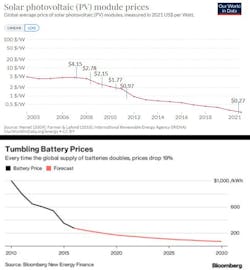The video (above) is Lee's presentation at the 2023 Trenton Computer Festival.
This video is part of the TechXchange: EV Battery Management.
What you’ll learn:
- Why the declining price of batteries could enable EVs to compete directly with ICE-powered cars in the near future.
- Why EV batteries appear to be following the same trends that enable the solar industry to become a rapidly growing quarter-trillion dollar global industry.
- How electric propulsion will enable new classes of vehicles that may change the way we travel, work, and play.
I discovered lots of interesting stuff when I was asked to give a talk on the future of electric vehicles, including the fact that it looks like they're closer becoming fully competitive with most classes of fossil-fueled cars and trucks than I'd thought. As I told my audience, this is in good part due to the rapid evolution of lithium-based batteries, and the emergence of several other viable low-lithium and lithium-free battery architectures (Fig. 1).
My talk, presented as the keynote for the Trenton Computer Festival (the world's longest-running DIY computer conference) also covered lots of interesting topics, including electric aviation and on how Star Trek influenced many future engineers. You can watch this talk in the video above.
In case you don't have an hour to spare (or can't stand my lame jokes), you can read the highlights of what I covered in an article I wrote titled "What Can the Solar Revolution Tell Us About the Future of EVs?" Among other things, it used two charts to illustrate the almost eerie similarities between the so-called "solar boom" that occurred between 2008 and 2011, and the growth curve of the EV battery industry.
One chart illustrates how the cost per watt of photovoltaic cells fell from over $4/W in 2007 to under $1/W by 2011, while the other one shows that Li-Ion batteries are in the middle of a remarkably similar trajectory that should bring them from $200/kWh in 2020 to $100/kWh (or less) by 2024 (Fig. 2). And EV manufacturers can expect even more impressive improvements in battery cost, capacity, and weight as advanced Li-ion architectures and the first solid-state chemistries begin commercial production in the 2024/25 timeframe.
Of course cheap batteries alone won't be enough to enable a rapid transition to an electrified future. Among other things, tomorrow's EVs will require motors that can be built with few, if any, rare earth elements, or other "strategic" materials (recently discussed in my three-part series "Helping EVs Kick the Rare Earth Habit").
In addition, the widespread adoption of EVs will depend on the widespread availability of fast, convenient, and affordable public charging stations. While it's too early to draw any conclusions, the recent announcements by Ford, GM, Honda, and others that they will be adopting Tesla's NACS charging interface are a good first step toward worry-free long-distance electric travel. And the recent agreement by BMW, General Motors, Honda, Hyundai, Kia, Mercedes, and Stellantis to jointly construct a massive national charging network should also go a long way to moving EVs to the steep part of the adoption curve—assuming the automakers can actually pull it off.
It's going to be an interesting story that I hope to share with you as it develops. Stay tuned here for details.
View more videos and read more articles in the TechXchange: EV Battery Management.


